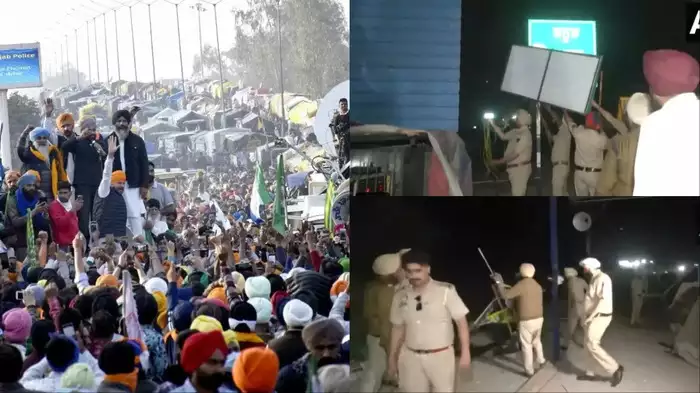Farmers Protest: The long-standing farmers’ protest at the Shambhu and Khanauri borders in Punjab has come to an abrupt end. After more than a year of continuous demonstrations, the Punjab Police, under the leadership of the Bhagwant Mann government, took decisive action to clear the protest sites. Tents were bulldozed, and farmers were removed late at night.
This drastic move raises several questions:
Why did the Aam Aadmi Party (AAP) resort to this measure? What role does Arvind Kejriwal’s visit to Punjab play? And how are industrialists involved in this controversial decision?
Table of Contents

Why The Punjab Police Cleared The Protest Sites
The Punjab Police launched their operation late at night, uprooting the tents of farmers stationed at Shambhu and Khanauri borders. This action was reportedly part of a well-planned strategy by the AAP government. According to sources, the Bhagwant Mann administration had been preparing for this moment by deploying water cannons and a heavy police force on both borders.
However, the government was cautious. Instead of directly confronting farmer leaders at the site, they waited until prominent farmer leaders Sarwan Singh Pandher and Jagjit Singh Dalewala were away in Chandigarh for meetings with Union Ministers Piyush Goyal, Shivraj Singh Chauhan, and Prahlad Joshi. Although the meeting was inconclusive, the Punjab Police seized the opportunity and swiftly moved in to clear the borders.

The Kejriwal Connection and Industrial Pressure
The timing of this action is closely linked to Arvind Kejriwal’s recent tour of Punjab, particularly his visit to Ludhiana. According to insider reports, Ludhiana industrialists expressed their dissatisfaction with the ongoing protests to the AAP leadership. They highlighted how the prolonged demonstrations were hurting business operations and affecting the movement of goods and trucks.
Feedback from industrialists suggested that if the AAP government failed to resolve the situation, it could cost them votes in the upcoming Ludhiana by-elections. The Bhagwant Mann government, therefore, viewed this as a critical moment to make a decisive move and address the complaints of the business community.
Political Motivations Behind The Action
Several political motivations also seem to be at play. The Ludhiana by-election is a crucial test for the AAP government, which aims to establish a strong foothold in the region. Speculations are also circulating that winning this election would pave the way for Arvind Kejriwal to gain a Rajya Sabha seat, further strengthening AAP’s political ambitions.
Punjab Finance Minister Harpal Singh Cheema addressed the situation, stating that the farmers’ protests were directed at the central government, not the Punjab government. He even suggested that farmers could shift their demonstrations to Delhi if they wished to continue their protest.
Opposition Criticism
The crackdown has drawn strong criticism from both the Congress and BJP. They have accused the AAP government of betraying the farmers who have been peacefully protesting for over a year. The opposition argues that the move was politically motivated rather than a genuine attempt to resolve the issue.
What Lies Ahead?
With the protests now forcibly ended at Shambhu and Khanauri borders, the focus shifts to how farmers will respond to this crackdown. Additionally, the impact on the Ludhiana by-elections remains to be seen. Will the AAP’s aggressive strategy pay off, or will it backfire?
Also read:

